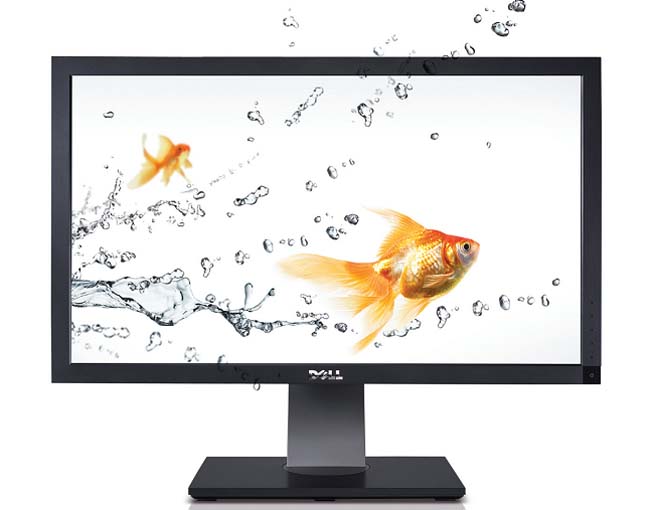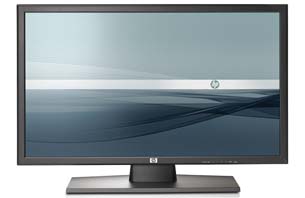State of the Art: LCD Desktop Monitors
Widescreen is standard as TFT active matrix LCDs are nearly ubiquitous, but the 16:10 aspect ratio might be completely eliminated by a standard 24-in. 16:9 ratio soon.
Latest News
June 1, 2010
By Mark Clarkson
Six months, or even a year ago, nearly every computer monitor sold used a TFT active matrix LCD. It’s the same now. It’ll be the same in six months.
But underneath, things are evolving at a furious pace.
 The Dell UltraSharp U2711 is a 27 in. screen with a 16:9 aspect ratio with in-plane switching. |
No Longer Hip to be Square
One change is apparent on the outside: ‘square’ 4:3 monitors have all but disappeared from the marketplace, replaced by 16:10 widescreen monitors.
The 16:9 aspect ratio—a better fit for movies—is becoming more common and may, ultimately, replace its slightly taller brethren. You and I might prefer the bit of extra real estate 16:10 affords, but that’s ultimately secondary to screen size and resolution.
LCD monitors have also, on average, grown. The mainstream commercial form factor is now 24 in.; five years ago it was 19 in.
Monitor resolution, which has been stuck at around 100 pixels per inch (ppi) for years, may be on the way up. Dell’s new 27 in. U2711 16:9 monitor, for example, squeezes in 2560 horizontal pixels, for about 108 ppi. There have been high-resolution monitors before, and they haven’t sold very well, but the resolution independence of Vista and Windows 7 make higher resolutions more attractive.
120Hz monitors are becoming common. While driven in large part by the demands of PC gamers, faster monitors are essential to support upcoming 3D schemes, which require twice the data rate. For most of us, right now, 60Hz is still quite comfortable.
 The latest in HP’s engineering monitors range in size from 24 in. to 42 in. |
You’re also finding more and more ancillary features—USB hubs, card readers, built-in invisible speakers and web cams—a sure sign of the maturity of the technology.
TN—Granddaddy Of Them All
More important by far than the webcams and other tchotchkes, though, is the underlying panel technology. And there’s a problem; few monitor specs even tell what the underlying technology is. All you get is: “LCD display/TFT active matrix.” This means exactly nothing, as every single LCD monitor on the market uses some form TFT active matrix technology. But which form, exactly? That turns out to be rather important. Let’s look at the most popular varieties.
Twisted nematic (TN) is the oldest LCD panel technology in wide deployment today. (The name refers to underlying physics and the twisted arrangement of the liquid crystal cells. You can learn more about the twisted nematic effect, here: hwikipedia.org/wiki/Twisted_nematic)
TN panels completely dominate the consumer market. They’re fast and cheap, but there’s an old saying: “Fast, cheap, and good—pick any two.”
That’s not entirely fair, though; TN panels are good and, in some cases, very good, but they’re not great. Their biggest problem is their limited viewing angle. You’ve seen it; the farther away from perpendicular your eyes get—especially vertically—the worse the display looks. Contrast fades, colors shift, and even invert.
TN technology has come a long way, and current TN monitors are greatly improved, but this problem, though ameliorated, persists.
Or Not TN
In-plane switching (IPS), on the other hand, provides very wide viewing angles, and the best color reproduction. It is very popular in color-critical applications including design and medical imaging. IPS panels originally had trouble with response time and contrast but, like TN, they have improved markedly over time.
Patterned vertical alignment (PVA) offers excellent contrast, and viewing angles and color reproduction nearly as good as IPS.
Each of these technologies is available in many flavors; you’ll find Super-PVA, Super-IPS, and even Advanced Super-IPS. And while my characterizations of them are couched in the most general terms, as a rule of thumb, PVA and IPS are at the high end, and TN is at the low. While TN panels are generally limited to 6-bit color, for example, most IPS and PVA panels support 8-bit color or more.
In many applications, such as large displays for conference rooms or factory floors, PVA and IPS are seen as more-or-less comparable technology as they both offer good off-angle viewing and color reproduction. TN panels, on the other hand, are rarely used in such applications, if ever.
None of these panel types is especially new, but IPS and PVA panel technologies are increasingly available in the professional and consumer marketplaces.
Backlight
Behind the crystal, the backlight is changing too, as cold cathode fluorescent lamps (CCFLs) are phased out in favor of LEDs.
LEDs bring two big advantages: they’re “green,” and they’re thin. Unlike CCFLs, LEDs contain no toxic mercury. Their thinner form factor allows for smaller, lighter displays. LEDs are also easier to tweak via software and firmware to compensate for environment, power usage, and wear.
White LED backlights (actually blue LED plus a yellow phosphor) are the most common, but RGB LED backlights, which produce the widest color gamut—wider than the best CCFLs—are increasingly available in high-end desktop monitors and notebooks.
State Of The Art
What does today’s state-of-the-art monitor look like? It’s probably a 30-in., 2560 x 1600 LCD display, with an RGB LED backlight and an IPS or PVA panel. It runs at 60Hz; for now at least, you’ll only find 120Hz matched to RGB LED backlights in televisions.
LaCie’s 30-in. Super-PVA-powered 730 is a good example. Its street price—$3,400—bespeaks its nearness to the cutting edge.
HP’s smaller 24-in. DreamColor LP2480zx, built on a 10-bit IPS panel and RGB backlight, weighs in at half the price ($1,700) and delivers an impressive billion-color gamut.
If your budget is … somewhat smaller, $350 will buy you a nice 22-in. S-PVA. And you might be surprised at how good the latest TN panels are.
Technology advances in a kind of punctuated equilibrium. A new technology bursts onto the scene, displaces an existing technology, and then settles in until it is replaced in turn. When it comes to monitors, this is the LCD’s time to shine. There isn’t even a new technology on the horizon; the best contenders—OLED and electronic ink—are years away from mounting a credible threat.
More Info:
Dell
EIZO
HP
LaCie
Lenovo
LG Electronics
NEC
Panasonic
Contributing Editor Mark Clarkson is DE’s expert in visualization, computer animation, and graphics. His newest book is “Photoshop Elements by Example.” Visit him on the web at markclarkson.com or send e-mail about this article to [email protected].
Subscribe to our FREE magazine, FREE email newsletters or both!
Latest News
About the Author
Mark ClarksonContributing Editor Mark Clarkson is Digital Engineering’s expert in visualization, computer animation, and graphics. His newest book is Photoshop Elements by Example. Visit him on the web at MarkClarkson.com or send e-mail about this article to [email protected].
Follow DE





